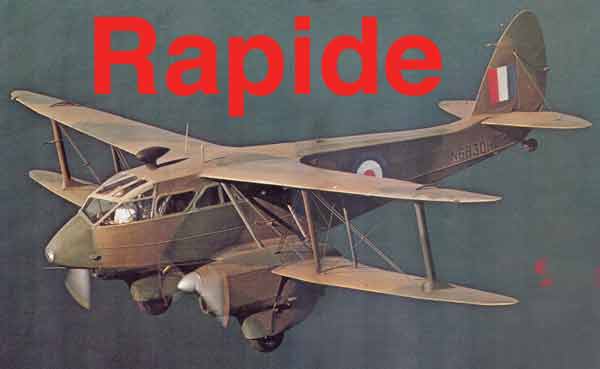
 |
de Havilland Rapide Pilot Report |
PAGE TWO
It was at Hollister that I finally caught up with Bob Puryear and his elephantine biplane. He was installing new batteries, getting the Rapide ready for a flight back to Burlington, Wisconsin, where he was going to donate the airplane to the EAA museum. He'd flown the airplane for several years, and he decided to spread its elegance around, putting it on display. It was a bit dusty and musty, having spent several flightless months in the huge WW-II hangar at Hollister, and as we rolled it out into the sunlight, it seemed to smile a little and stand a little taller. As I helped Puryear preflight it, I was continually amazed at the mechanical contradictions the airplane contains. The basic airframe is just that, basic. It was meant to be economical to build and maintain but at the same time, it has many small details that you notice immediately. For instance, the door latch is an exquisitely machined mechanism that moves, snicks and snacks as it does its task. The internal workings are surely one of the more complex parts of the airplane. The long cabin retains its smallish, military-style, leather-covered bucket seats, arranged to get a maximum number of people into a minimum of space without compromising comfort. The cockpit, however, is something else. The pilot hangs from the front of the plywood fuselage box, the nose tapering sharply toward his feet. He's up there all by himself and has to squeeze into the jumble of knobs, wheels and levers through a narrow door on the right side of the front cabin bulkhead. The cockpit reeks of the quaint details that separate British wartime aircraft from all others. For instance, the old-fashioned, nautical-style horizontal compass swings in its gymbaled mount so as to always be level. What few instruments there are, are randomly scattered around the cockpit, and only repeated exposure to the collection would help you find any particular gauge quickly. Puryear's Rapide went from the RAF into the airlines and then into aerial survey, and somewhere along the line its Gypsy Six engines were replaced by a pair of 210-hp Gypsy Queens fitted with constant-speed props. A wise choice, but then the prop controls were mounted on the right side of the cockpit—and the throttles are still on the left side. I watched Puryear move in and out on the camera plane, effortlessly holding and changing position on command, and I marveled at the way he made the huge machine behave like a nimble bird. I was also amazed to notice split trailing-edge flaps on the bottom wing dangling between the engines and the fuselage when he landed. It wasn't until my turn came to go flying with him that I found the Rapide's performance is far different than its appearance would have you believe. Because of a brake problem (either none at all, or one that grabbed viciously), we decided not to risk ending the old gal's career at the hands of an overeager neophyte, so takeoff and landings were made by Puryear with me perched on his shoulder monitoring things closely. Once in the air, I could play with the controls and find what a true lady the airplane could be. The tailwheel is full-swiveling, so all directional control is either from the rudder, differential power or brakes, and the brakes are most important at both the beginning and end of the takeoff and landing rolls. As Puryear aimed the airplane down the centerline and edged the two steamboat throttles forward, the Rapide decided it was eager to go flying, and accelerated much faster than you would imagine for such a massive machine. As the power went in and speed built up, the floppy-looking rudder took hold and almost as soon as the tail was up, the airplane's gigantic dragonfly wings brought it effortlessly up off the runway.
I would have given anything to spend a few hours by myself tooling around the Big Sur area beneath us, landing at little out-of-the-way strips to see what was hiding in tired-looking hangars, but that was impossible, and I was happy just to have the opportunity to try the controls in the air. And what a surprise that opportunity turned out to be! I had expected the ailerons to be languid and heavy, forcing me to fight to move the wings, but they were just the opposite. They may have been a tad stiff, but the California horizon tilted immediately when I moved the wheel the slightest bit. The elevator and rudder were even lighter, bordering on sensitive, making the controls of this Grade-A cotton behemoth something akin to a modern light twin, say a Cessna 310, maybe. Of course, the overpowering funkiness of the cockpit can't be touched by the likes of modern sheet-iron airplanes. After a while the character and soul of the airplane make you forget the clunky instrument panel and compass setup, and you wish you could stay up forever. However, that wasn't to be. After flying around the coast for a while, we turned back to Hollister, cruising at a solid-120 knots and burning 26 gallons an hour. Puryear shouted that he could cruise all day at 100 knots and 23 gallons, while carrying eight people and baggage with him. We came down final just a shade above Vmc speed of 80 knots and Puryear reached for the flaps. Since most biplanes are very dirty and don't need flaps, I asked Puryear about it. He said without the high drag of the flaps, the Rapide would float forever. The only touchy part of the rollout, he said, was just after dropping the tail on a wheel landing. And, although I couldn't do a true I-came-I-saw-I-flew pirep, speaking authoritatively of her many nuances, I did have a brief flirtation with a great lady. BD Wingspan ........................ 48 ft |